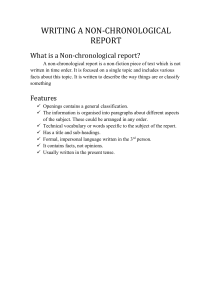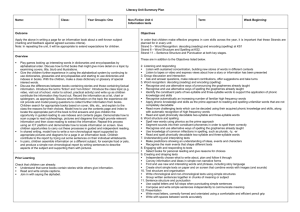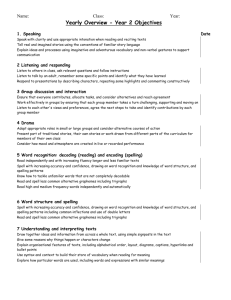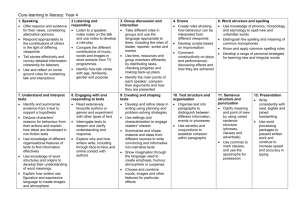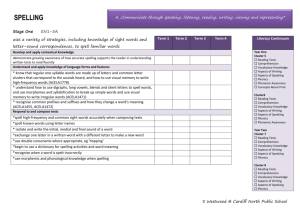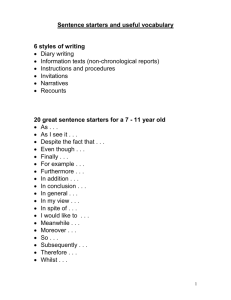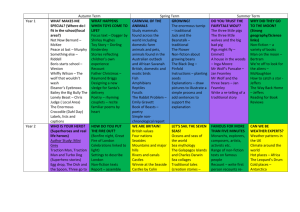Sherwood Primary School – National Literacy Strategy Weekly
advertisement
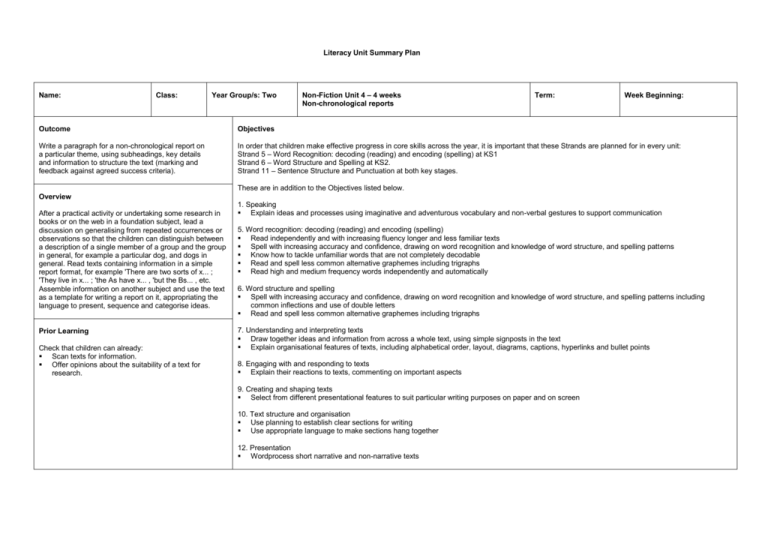
Literacy Unit Summary Plan Name: Class: Year Group/s: Two Non-Fiction Unit 4 – 4 weeks Non-chronological reports Term: Week Beginning: Outcome Objectives Write a paragraph for a non-chronological report on a particular theme, using subheadings, key details and information to structure the text (marking and feedback against agreed success criteria). In order that children make effective progress in core skills across the year, it is important that these Strands are planned for in every unit: Strand 5 – Word Recognition: decoding (reading) and encoding (spelling) at KS1 Strand 6 – Word Structure and Spelling at KS2. Strand 11 – Sentence Structure and Punctuation at both key stages. These are in addition to the Objectives listed below. Overview After a practical activity or undertaking some research in books or on the web in a foundation subject, lead a discussion on generalising from repeated occurrences or observations so that the children can distinguish between a description of a single member of a group and the group in general, for example a particular dog, and dogs in general. Read texts containing information in a simple report format, for example 'There are two sorts of x... ; 'They live in x... ; 'the As have x... , 'but the Bs... , etc. Assemble information on another subject and use the text as a template for writing a report on it, appropriating the language to present, sequence and categorise ideas. Prior Learning Check that children can already: Scan texts for information. Offer opinions about the suitability of a text for research. 1. Speaking Explain ideas and processes using imaginative and adventurous vocabulary and non-verbal gestures to support communication 5. Word recognition: decoding (reading) and encoding (spelling) Read independently and with increasing fluency longer and less familiar texts Spell with increasing accuracy and confidence, drawing on word recognition and knowledge of word structure, and spelling patterns Know how to tackle unfamiliar words that are not completely decodable Read and spell less common alternative graphemes including trigraphs Read high and medium frequency words independently and automatically 6. Word structure and spelling Spell with increasing accuracy and confidence, drawing on word recognition and knowledge of word structure, and spelling patterns including common inflections and use of double letters Read and spell less common alternative graphemes including trigraphs 7. Understanding and interpreting texts Draw together ideas and information from across a whole text, using simple signposts in the text Explain organisational features of texts, including alphabetical order, layout, diagrams, captions, hyperlinks and bullet points 8. Engaging with and responding to texts Explain their reactions to texts, commenting on important aspects 9. Creating and shaping texts Select from different presentational features to suit particular writing purposes on paper and on screen 10. Text structure and organisation Use planning to establish clear sections for writing Use appropriate language to make sections hang together 12. Presentation Wordprocess short narrative and non-narrative texts Phase 1 – approx 5 days Phase 1 Learning outcomes Resources Read and compare paper and ICT-based non-chronological reports. Identify common features; evaluate effectiveness of text to support reading pathways. Children can identify the main features of a non-chronological report, including grammatical features and key vocabulary. Children can evaluate nonchronological reports, expressing their views clearly and using evidence from the text. Phase 2 – approx 4 - 5 days Phase 2 Learning outcomes Plan a non-chronological report identifying a general theme, using subheadings, key details and information. Children can organise their ideas into general themes, subheadings, key details and information. Phase 3 – approx 8 - 9 days Phase 3 Learning outcomes Demonstrate how to organise ideas under subheadings into a paragraph. Children write their own non-chronological reports arranged into simple paragraphs. Children can write a paragraph on a theme, using subheadings, key details and information to structure the text. Range of ICT-based and paper non-chronological reports ICT suite or laptops Presentation software ICT template for non-chronological report IWB skeletons Text comparison grid Developing early writing, Ref: 0055/2001 http://www.standards.dfes.gov.uk/primary/publications/literacy/63337/ Y2 science non-chronological report writing - non-fiction case study (web-based only) http://www.standards.dfes.gov.uk/primary/casestudies/literacy/403685/617053/ Writing flier 7 - Non-chronological report: telling it like it is…or was, Ref: 0532/2001 http://www.standards.dfes.gov.uk/primary/publications/literacy/63353/nls_teachwriting053201rep7.pdf (PDF 194 Kb) Boys' writing flyers, Ref: 1170/2005 G http://www.standards.dfes.gov.uk/primary/publications/literacy/1128197/ Speaking, listening, learning: working with children in Key Stages 1 and 2, Ref: 0627-2003 G http://www.standards.dfes.gov.uk/primary/publications/literacy/818497/pns_speaklisten062403acts.pdf (PDF 757 Kb) The National Curriculum in action website includes examples of non-chronological report writing in other subjects at Year 2 http://www.ncaction.org.uk/search/index.htm Resources for Year 2, Non-Fiction, Unit 4, Reports Word 33KB PDF 24KB RTF 16KB
